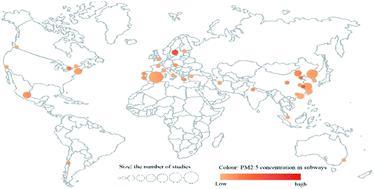当前位置:
X-MOL 学术
›
Environ. Sci.: Processes Impacts
›
论文详情
Our official English website, www.x-mol.net, welcomes your feedback! (Note: you will need to create a separate account there.)
Recent progress in research on PM2.5 in subways
Environmental Science: Processes & Impacts ( IF 5.5 ) Pub Date : 2021-3-23 , DOI: 10.1039/d1em00002k Li Chang 1, 2, 3, 4, 5 , Wen Tong Chong 1, 2, 3, 4, 5 , Xinru Wang 6, 7, 8 , Fei Pei 8, 9, 10, 11 , Xingxing Zhang 12, 13, 14, 15, 16 , Tongzhao Wang 8, 17, 18 , Chunqing Wang 8, 19, 20, 21 , Song Pan 8, 9, 10, 11
Environmental Science: Processes & Impacts ( IF 5.5 ) Pub Date : 2021-3-23 , DOI: 10.1039/d1em00002k Li Chang 1, 2, 3, 4, 5 , Wen Tong Chong 1, 2, 3, 4, 5 , Xinru Wang 6, 7, 8 , Fei Pei 8, 9, 10, 11 , Xingxing Zhang 12, 13, 14, 15, 16 , Tongzhao Wang 8, 17, 18 , Chunqing Wang 8, 19, 20, 21 , Song Pan 8, 9, 10, 11
Affiliation

|
Nowadays, PM2.5 concentrations greatly influence indoor air quality in subways and threaten passenger and staff health because PM2.5 not only contains heavy metal elements, but can also carry toxic and harmful substances due to its small size and large specific surface area. Exploring the physicochemical and distribution characteristics of PM2.5 in subways is necessary to limit its concentration and remove it. At present, there are numerous studies on PM2.5 in subways around the world, yet, there is no comprehensive and well-organized review available on this topic. This paper reviews the nearly twenty years of research and over 130 published studies on PM2.5 in subway stations, including aspects such as concentration levels and their influencing factors, physicochemical properties, sources, impacts on health, and mitigation measures. Although many determinants of station PM2.5 concentration have been reported in current studies, e.g., the season, outdoor environment, and station depth, their relative influence is uncertain. The sources of subway PM2.5 include those from the exterior (e.g., road traffic and fuel oil) and the interior (e.g., steel wheels and rails and metallic brake pads), but the proportion of these sources is also unknown. Control strategies of PM mainly include adequate ventilation and filtration, but these measures are often inefficient in removing PM2.5. The impacts of PM2.5 from subways on human health are still poorly understood. Further research should focus on long-term data collection, influencing factors, the mechanism of health impacts, and PM2.5 standards or regulations.
中文翻译:

地铁PM2.5研究的最新进展
如今,PM 2.5的浓度极大地影响着地铁的室内空气质量,并威胁到乘客和员工的健康,因为PM 2.5不仅体积小,比表面积大,而且还含有重金属元素,还可能携带有毒有害物质。探索地铁中PM 2.5的理化特性和分布特性对于限制其浓度并去除它是必要的。目前,世界上有关地铁中的PM 2.5的研究很多,但是,没有关于此主题的全面而有条理的评论。本文回顾了近二十年来的研究以及关于PM 2.5的130多项已发表的研究在地铁站中,包括浓度水平及其影响因素,理化特性,来源,对健康的影响和缓解措施等方面。尽管在当前研究中已报告了许多站台PM 2.5浓度的决定因素,例如季节,室外环境和站台深度,但它们的相对影响尚不确定。地铁PM 2.5的来源包括外部(例如道路交通和燃油)和内部(例如,钢制的车轮和轨道以及金属制的刹车片),但这些来源所占的比例也未知。PM的控制策略主要包括足够的通风和过滤,但是这些措施通常在去除PM 2.5方面效率低下。地铁PM 2.5对人体健康的影响仍然知之甚少。进一步的研究应集中在长期数据收集,影响因素,健康影响机制以及PM 2.5标准或法规上。
更新日期:2021-04-23
中文翻译:

地铁PM2.5研究的最新进展
如今,PM 2.5的浓度极大地影响着地铁的室内空气质量,并威胁到乘客和员工的健康,因为PM 2.5不仅体积小,比表面积大,而且还含有重金属元素,还可能携带有毒有害物质。探索地铁中PM 2.5的理化特性和分布特性对于限制其浓度并去除它是必要的。目前,世界上有关地铁中的PM 2.5的研究很多,但是,没有关于此主题的全面而有条理的评论。本文回顾了近二十年来的研究以及关于PM 2.5的130多项已发表的研究在地铁站中,包括浓度水平及其影响因素,理化特性,来源,对健康的影响和缓解措施等方面。尽管在当前研究中已报告了许多站台PM 2.5浓度的决定因素,例如季节,室外环境和站台深度,但它们的相对影响尚不确定。地铁PM 2.5的来源包括外部(例如道路交通和燃油)和内部(例如,钢制的车轮和轨道以及金属制的刹车片),但这些来源所占的比例也未知。PM的控制策略主要包括足够的通风和过滤,但是这些措施通常在去除PM 2.5方面效率低下。地铁PM 2.5对人体健康的影响仍然知之甚少。进一步的研究应集中在长期数据收集,影响因素,健康影响机制以及PM 2.5标准或法规上。



























 京公网安备 11010802027423号
京公网安备 11010802027423号